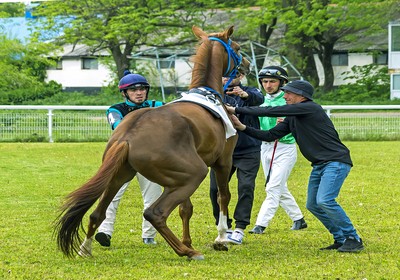 Anyone familiar with the sport of horse racing will be well aware that, whilst horse and rider almost always leave the stalls or start line in tandem, they don’t always reach the winning post that way. Even in the shortest races on the Flat, much can happen and this unpredictability is part of the appeal of racing.
Anyone familiar with the sport of horse racing will be well aware that, whilst horse and rider almost always leave the stalls or start line in tandem, they don’t always reach the winning post that way. Even in the shortest races on the Flat, much can happen and this unpredictability is part of the appeal of racing.
Once a race has begun, there are numerous ways in which horse and human can become separated – particularly in the National Hunt (jumps) arm of the sport. Whether via a fall, a balance-related unseat, or a horse simply refusing to jump a fence and sending the jockey earthwards, those brave riders are frequently given a close-up view of the lush green grass – and often mud – of British racecourses.
Such an outcome is a disappointing result whenever it occurs, for owners, trainers, jockeys, and those unfortunate enough to have included the horse in their betting selections. But can’t the jockey simply dust themselves down, climb back on, and set out once more in pursuit of victory?
The quick answer to that question is: in the past, they could, but now they can’t, with a rule change introduced in 2009 banning the remounting of a horse at any point after the race has begun.
Here we take a look at how things used to work in the past, the changes to the rules over the years and the thinking behind these alterations.
Remounting Before a Race Begins is Permitted
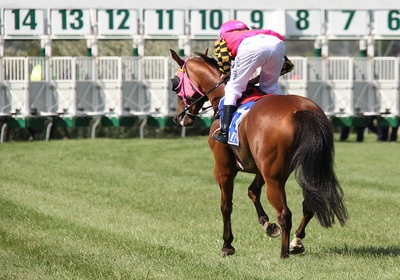 The first thing to note is that whilst remounting once the race is underway is now strictly prohibited, jockeys who become detached from their horse before the start of a race are allowed to remount. This is subject to the on-course vets and doctors being satisfied that neither the horse nor rider has suffered an injury.
The first thing to note is that whilst remounting once the race is underway is now strictly prohibited, jockeys who become detached from their horse before the start of a race are allowed to remount. This is subject to the on-course vets and doctors being satisfied that neither the horse nor rider has suffered an injury.
This type of remounting actually occurs relatively frequently.
Unpredictable beasts as they are, many racehorses don’t even wait for the race to begin before unshipping their rider, whether that be in the parade ring, on the way down to the start or, most commonly, when the runners are entering the starting stalls.
Whenever this occurs, both horse and jockey will be examined and – provided neither has suffered an injury, and the horse’s tack (saddle, reins, shoes etc.) is intact – the jockey will be allowed to remount and take part in the race.
The rules surrounding these pre-race remounts have changed very little over the years, but those regarding remounting once the race is underway have undergone a number of significant alterations.
Pre-2005: Remount at Your Leisure
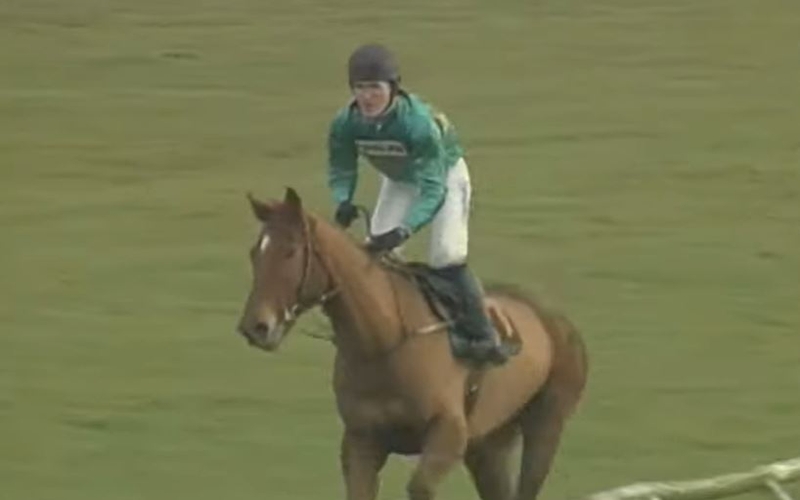
Before 2005, whilst it wasn’t quite a case of “anything goes”, in retrospect, it seems fair to say that the rules surrounding remounting were a little lacking. Having fallen, unseated, or otherwise become detached from their ride, jockeys were permitted to remount and continue in the race at their discretion. More often than not, this decision was taken out of the jockey’s hands anyway as – having gotten rid of their jockey – the natural instinct of most horses will see them carry on galloping after the other runners in the field, leaving their unshipped sitting/standing/fuming rider well behind.
However, there were occasions when the jockey was able to regather their mount, climb back aboard and rejoin the race – most often with very little chance of winning, but with the hope of at least picking up some prize money for themselves and connections.
The most famous such remounting incident came at Southwell on the 23rd of January 2002. Seeing a chase won by Sir A P McCoy was, of course, far from unusual, but of the 4,348 wins he racked up during his record-setting career, none were so strange as that which came in the carnage strewn Feast of St Raymond Novices’ Chase.
Falling at the 10th fence aboard Family Business, you would think that even McCoy would struggle to win from there. However, Sir Anthony was never a man to give up easily. Having looked on as every other runner in the field also fell, he caught up with Family Business, returned to the 10th obstacle and completed the course in his own time. A farcical state of affairs in hindsight. However, the race will likely be remembered fondly by at least one individual – namely the inspired Betfair punter who backed Family Business at the maximum odds of 999/1 following his fall.
2005 Alterations
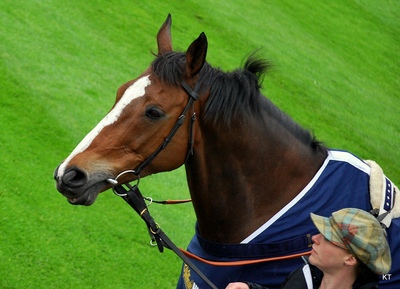
There had been rumblings in the racing industry regarding a change in approach to remounting ever since that McCoy miracle at Southwell. However, it was a 2005 incident involving the brilliant Kauto Star which initiated the first tightening of the rules.
Making only his second British start when heading to Exeter for the Weatherbys Bank Novices Chase, Kauto Star had shown enough in his previous outing to be installed as the Ante Post favourite for the Arkle Chase at the Cheltenham Festival and was in the process of building on that reputation when fully 12 lengths clear at the second last – only for disaster to strike.
It was a mighty effort by the horse to almost get back up on the line, but those exertions came at some cost. Following the race, it came to light that Kauto Star had suffered a fracture when falling and exacerbated the injury during that lung-busting final effort – resulting in a nine-month absence from the track. Thankfully, Kauto Star made a full recovery, but the remounting rules of the time possibly almost deprived racing of a horse who would go on to win five King George VI Chases and two Cheltenham Gold Cups.
Events at Exeter appeared to spark the sport’s governing body into action, with a tightening of the rules introduced in September of that year. Despite the protestations of the RSPCA and veterinary bodies, the British Horseracing Authority (BHA) fell short of introducing an outright ban on remounting – choosing instead to discourage the riders from climbing back into the saddle unless certain their mount had not sustained an injury. Under the amended rules, jockeys deemed to have remounted an injured or exhausted horse would be in breach of the rules regarding improper riding, and penalised with a ban ranging from three to 14 Days.
Unsurprisingly, given these stringent penalties, jockeys became far more cautious when it came to remounting, seeing the average number of remounts per season fall from a pre-2005 level of 30-40 per season to an average of only eight or nine.
2009: The Introduction of the Current Rules
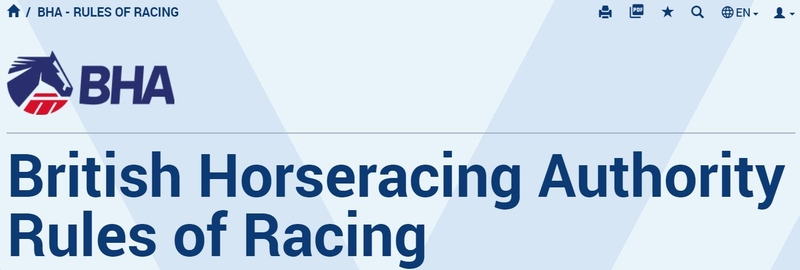 Whilst the 2005 rule change was a welcome step in the right direction, the issue remained under review. Then, in 2009, the racing bodies outlawed the process altogether, with the ban on remounting a horse during a race coming into effect on 2nd November 2009.
Whilst the 2005 rule change was a welcome step in the right direction, the issue remained under review. Then, in 2009, the racing bodies outlawed the process altogether, with the ban on remounting a horse during a race coming into effect on 2nd November 2009.
Whilst acknowledging that the ban came with possible unwanted consequences – specifically an uninjured horse being unable to be remounted and therefore claim a share of prize money for connections – on balance, the detrimental effects of remounting upon runner and rider were deemed to far outweigh any potential negatives resulting from the ban.
BHA official Paul Struthers summed up the reasoning behind the ban when stating, “This rule change is the result of a recommendation from our welfare and training group, which was approved by our board, because of the indisputable risk to both horse and jockey.”
Under the new rules, any horse remounted after the start of a race will be disqualified – no matter where the remount occurs, be it immediately after the start, following the final fence or hurdle with no further obstacles remaining, or anywhere in between. Jockeys are also now forbidden from remounting the horse in order to ride back to the stabling area, unless both horse and jockey are deemed fit by the on-course vets and doctors.
A Race with No Finishers
One consequence of the new laws is that it is now possible that a race may end with none of the field having managed to complete the course. Thankfully, this is an exceedingly rare occurrence, but did come to pass at Towcester Racecourse in 2011.
A race that does not produce a winning result seems rather unfair to punters and, happily, the betting industry agrees with this view. Any such race, in which none of the runners completes the course, is declared void, and all stakes are refunded.
Common Sense Prevails

It seems to have taken a long time to get to this stage, but the ban on remounting has been widely accepted as a positive move, and a huge step in the right direction in regard to the welfare of the competitors.
The ban also eradicates a number of inconsistencies which existed under the previous rules. In the past, any jockey suffering a fall during a race would need to be passed fit by the doctor if they were to take up their rides in later events on the card, with this medical examination taking place following the conclusion of the race.
A sensible approach, but one which was at odds with the practice of allowing a jockey to fall during a race, and then pass themselves fit to remount and continue. This process created the possibility of a rider deciding they were fit to remount, only to be professionally examined after the race and informed that they had, in fact, sustained an injury.
In addition to assessing their own fitness to continue, under the old rules, jockeys were also required to determine the wellbeing of their mount. Talented as they are, jockeys are not veterinary surgeons. Expecting the riders to accurately assess any potential injuries in a small window of time seems unrealistic, and also a little harsh considering the punishments dished out if they were deemed to have made the wrong call.
The new rules effectively bring the welfare checks forward to the moment immediately following the fall or unseat, which can only be to the benefit of the horses and riders involved.
